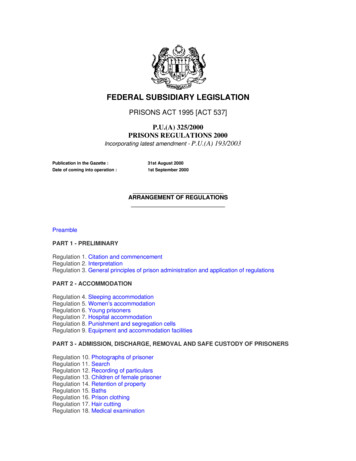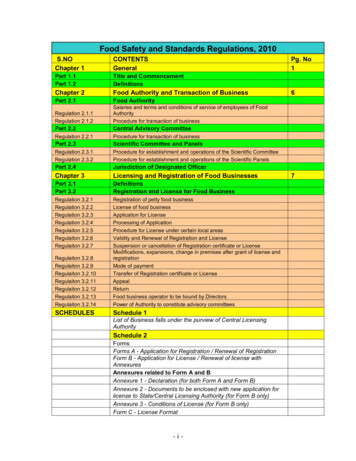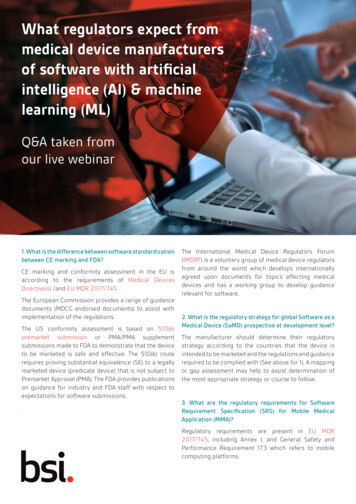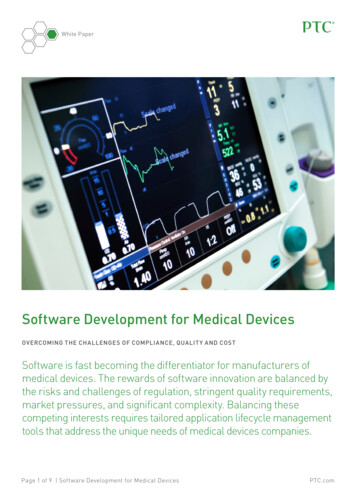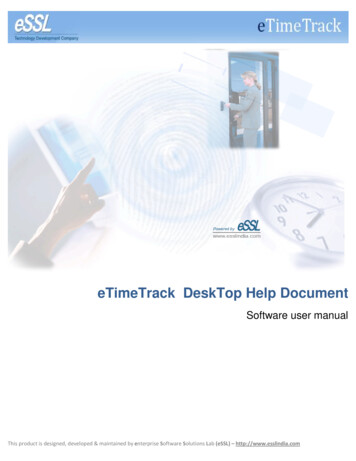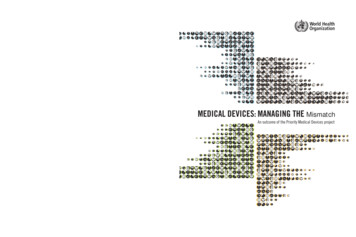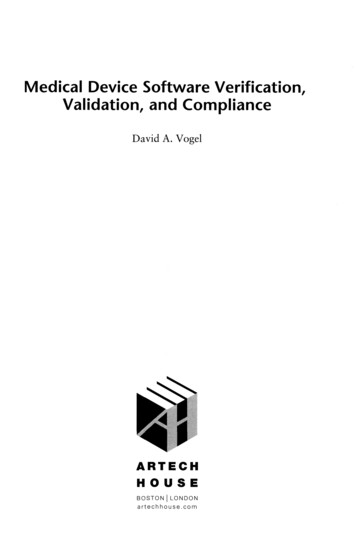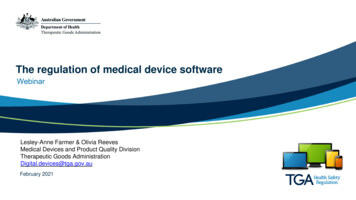
Transcription
The regulation of medical device softwareWebinarLesley-Anne Farmer & Olivia ReevesMedical Devices and Product Quality DivisionTherapeutic Goods AdministrationDigital.devices@tga.gov.auFebruary 2021
Overview What is SaMD? Reforms to medical device software regulation in Australia Is my product regulated? What do I need to do?2
What is SaMD? Software as a Medical Device– Software that runs on general purposeplatforms On a laptop, tablet or mobile phone On a server Web app Cloud based – software as a service Software in a Medical Device– Drives a medical device3
When is software a medical device?Software is a medical device when the manufacturerintends for its product to be used for: diagnosispreventionmonitoringprognosis & predictiontreatmentalleviation of disease, injury or disabilityIt’s not based on what colour it iswhat shape it iswhether or not it looks goodwhat it is calledwhether it is novel or notwhat technology is usedhow it is supplied (online, in hardware,through the sneaker net, )Intended purpose is critical 4
Medical device software regulation Program of reforms- broad program of reforms to Medical Device regulation- Review of Medicines and Medical Device Regulation (MMDR) International alignment- International Medical Device Regulators Forum (IMDRF)- Health Canada, EU, US FDA Software specific consultations5
Consultations on software2019Regulation of software, including Software as a Medical Device (SaMD). regulation changes made Dec 2019 (commences on 25 Feb 2021)2020Scope of regulated software-based products (the “carve out”) closed May 2020 48 submissions received from a broad range of respondents analysis published on TGA website further meetings held with targeted stakeholders6
Regulatory change for softwareChanges to Essential Principles: EP 12.1 amended to clarify the requirements for:–cyber security–the management of data and information–requirements relating to development, production, and maintenance. EP 13.2(3) amended to allow information to be provided electronically. New EP 13B introduced requiring the current version and build number for the software to bemade accessible and identifiable to users of software-based medical devices. This informationmust be in English, however may also be displayed in other languages.7
Regulatory change for softwareChanges to the classification rules for software intended for:‒‒‒‒diagnosing and screening for a disease or conditionmonitoring the state or progression of a disease or conditionspecifying or recommending a treatmentproviding therapy (via provision of information) Changes to EPs and classification rules commence on 25 February2021 - transition period until 1 November 2024 Notification required for devices needing classification8
Carve out consultation Sought feedback on:– Measures to clarify the boundary of regulatedproducts– proposal to “carve-out”, certain groups of softwaremedical devices that would normally be regulated bythe TGA Two primary guiding considerations for the carve-out:– Device presents a low risk to safety– Alternative oversight schemes or systems are inplace9
Carve-out consultation Software as a Medical Device(SaMD) is a subset of healthsoftware– The scope of ‘health software’ isbroader than ‘medical devicesoftware’– Most health software is not amedical device and is notregulated by the TGA.10
Carve-out mechanisms: Exclusion vs Exemption11
Carve-out mechanisms: Exclusion vs Exemption– Excluded products are not subject to any TGA oversight– Exempt products are Not required to be in the ARTG Do not have pre-market evaluation by the TGA Must meet the relevant essential principles for safety andperformance Must report adverse events to the TGA Are subject to recalls or hazard alerts in the event of a problem Are subject to the Therapeutic Goods Advertising Code12
Carve out consultation - outcomes clarification of boundary exemption for Clinical DecisionSupport Systems exclusion for a range of products guidance to illustrate boundary andchanges – guidance now published onTGA website commences on 25 Feb 202113
Software to be carved-out - Excluded15 Exclusions grouped into 5 categories:– Consumer health products - prevention, management and follow updevices that do not provide specific treatment or treatment suggestions– Enabling technology - for telehealth, remote diagnosis, healthcare ordispensing– Digitisation - of paper based or other published clinical rules or dataincluding simple dose calculators and Electronic Patient Records– Analytics - population based– Laboratory Information Management Systems14
Clinical decision support softwareExemption for clinical decision support software that is:a) intended to be for the sole purpose of providing or supporting arecommendation to a health professional about preventing,diagnosing, curing or alleviating a disease, ailment, defect or injury inpersons; andb) not intended by its manufacturer to directly process or analyse amedical image or signal from another medical device; andc) not intended by its manufacturer to replace the clinical judgement of ahealth professional in relation to making a clinical diagnosis ordecision about the treatment of patients15
Is my product carved-out?You need to consider the following.The order is important:–Is it a medical device (according to the definition)?–Does it meet any of the exclusions?If it is a medical device, determine if it meets the exemption for clinicaldecision support16
Is my product regulated?Need to consider Who is the manufacturer?- may be software developer, vendor, integrator . Is it a medical device?- what is the intended purpose Does it meet exemption or exclusion criteria?Flowchart and other guidance published on the TGA website17
Is my softwareregulated?Software can be part of a medical device. Thissoftware is sometimes referred to as SiMD(software in a medical device). The TGA regulatesthis software as part of that device.Software (includingapps)YesIs its purpose likelyto be medical?(see page 3)Software that analyses dataobtained from an IVD isregulated as IVD software.See Software as in vitrodiagnostic medical devices(IVDs) for more information.Does it work incombination with amedical device?NoYesIs it excluded?(see page 4)YesYesDoes it enable or assistwith the function ofthat medical device?Does it workdirectly with dataobtained in vitro?YesNoFor more detail see thefollowing pages:Medical Purpose Page 3Excluded software Page 4 and page 5Exempted clinicaldecision supportsoftware - Page 6Does it supportclinical decisions?It is not a medicaldeviceYesNoIt is an in vitrodiagnostic (IVD)medical deviceNoNoNoIt is an accessory(regulated as amedical device)YesIs the clinical decisionsupport software exempt?(see page 6)YesNoIt is a medicaldeviceIt is an exemptmedical deviceThis software is not regulated by theTGA. See Examples of regulated andunregulated (excluded) softwarebased medical devices for moreinformation.This software is an accessory. Anaccessory to a medical device issomething that its manufacturerspecifically intends to be used with amedical device to enable or assist it tobe used as intended.An accessory to a medical device isregulated as a medical device, andmust be entered on the ARTG prior tosupply. See How the TGA regulatessoftware based medical devices formore information.This software is a medical device andmust be entered on the ARTG prior tosupply. See How the TGA regulatessoftware based medical devicesand Examples of regulated andunregulated (excluded) softwarebased medical devices for moreinformation.This software is exempt clinicaldecision support software.18
We’re answering your questionsRegulation of software based medical basedmedical-devicesGeneral medical device enquiriesdevices@tga.gov.au1800 141 144The TGA’s Digital Devices teamdigital.devices@tga.gov.auwww.tga.gov.au19
Introduction to medical device regulation20
Who is the manufacturer? It’s not necessarily whophysically makes the device. It’s who has their name onthe label21
What do I need to do? Determine if your product is a medical device! Determine the classification Hold evidence of compliance with the essentialprinciples for safety, quality, and performance Obtain 3rd-party certification (if required) assessment of technical files inspection of QMS, manufacturing site(s) Apply for inclusion in the ARTG Follow post-market requirements– Monitor post-market performance– Report problems to the TGA– Annual manufacturing inspections22
Regulatory classificationClassificationRequirementsDegree of oversightClass III 3rd-Party, HighClass IIb 3rd-Party, MediumClass IIa, Im, Is 3rd-Party, LowClass I Self-certification23
The Essential Principles of Safety and PerformanceSchedule 1, Therapeutic Goods (Medical Devices) Regulations (2002)General principlesPrinciples about design and construction1. Use of medical devices not to compromisehealth and safety2. Design and construction of medical devicesto conform to safety principles3. Medical devices to be suitable for intendedpurpose4. Long-term safety5. Medical devices not to be adversely affectedby transport or storage6. Benefits of medical devices to outweigh anyside effects7. Chemical, physical and biological properties8. Infection and microbial contamination9. Construction and environmental properties10. Medical devices with a measuring function11. Protection against radiation12. Medical devices connected to or equipped withan energy source13. Information to be provided with medical devices14. Clinical evidence15. Principles applying to IVD medical devices onlywww.legislation.gov.au24
The Essential Principles – software requirementsEvidence generally expected for softwareSome of the evidence required: Quality management (QMS) records Release & version management Design control and validation Defect reporting and correction Clinical evidence Benefit must outweigh the risks25
Evidence of complianceSome of the standards you need to considerIEC 62304 – Medical device software — Software life cycle processesISO 13485 – Medical devices — Quality management systems —Requirement for regulatory purposesISO 14971 – Medical devices — Application of risk management to medicaldevicesPlus other standards that you identify as applicable toyour product26
3rd-party certificationInvolves an independent review Manufacturer must meet certain requirements Inspection/audit by 3rd party against those requirementsManufacturers are certified against the requirements Certificates issued for a certain scope of manufacture or design/typeCertification options in Australia European Union MDSAP US FDA / Health Canada MDSAP/QMS Japan TGA EU–Aus MRA27
Evidence of complianceBeyond standards Risk and quality management– Total product lifecycle (TPLC) State-of-the-art– Standards published and unpublished Best practice– Software engineering, clinical, other Product validation– Engineering, clinical, other28
What is a quality management system?Simply put, it is a system to assure quality inmanufacturing.More broadly, it’s also a means for manufacturers tomeet customer and regulatory requirements.In therapeutic goods regulatory schemes, a QMS isused for the management of quality but also for themanagement of safety and performance/efficacyof therapeutic goods.It’s up to you, as a manufacturer, to put in place asystem that works for you and your business.29
Quality management - introducing ISO 13485ISO 13485 is a technical standard based on ISO 9001 recognised by regulatory jurisdictions the world over principles based not mandatory in most jurisdictions (including Australia)Medical devices—Quality management systems—Requirements forregulatory purposes — ISO 13485: 201630
Post-market requirementsWork doesn’t stop when a product reaches the market it continues over the lifetime of every medical deviceAdverse events - when things go wrong: Monitor Respond, report Change controlRecalls or hazard alerts in the event of a problemCompliance with the Therapeutic Goods AdvertisingCodeInspections of manufacturing facilities31
Inspections of software manufacturersDesignDevelopTPLCMonitorThe manufacturer is expected to: design for safety and performance develop for quality, robustness, resilience,and predictability monitor, report, and improveusing appropriate, sufficient, robust, anddefensible tools, approaches, and methods.ImproveReport32
Cyber securityRegulatory guidance -device-cybersecurity-guidance-industry.pdf Total product life cycle Applying the Essential Principles Relevant standards Strategies for risk management Design and testing considerations Supply chain and platform security Post market monitoring, response and change control33
SME Assist Targets the needs of small to medium enterprises (SMEs), start-ups,researchers and those unfamiliar with therapeutic goods regulation Assists users with navigating the ‘regulatory maze’ Offers:– Guidance articles– Interactive decision tools (including ‘What classification is my medical device?’)– Educational face-to-face workshops across Australia (including a dedicatedmedical device focus session)– Email and phone support– A subscription service to keep up-to-date with news and events34
decision support software. This software is a medical device and must be entered on the ARTG prior to supply. See . How the TGA regulates software based medical devices and . Examples of regulated and unregulated (excluded) software based medical devices for more information. Software that analyses data obtained from an IVD is regulated as IVD .


